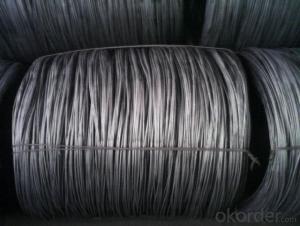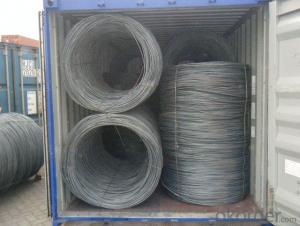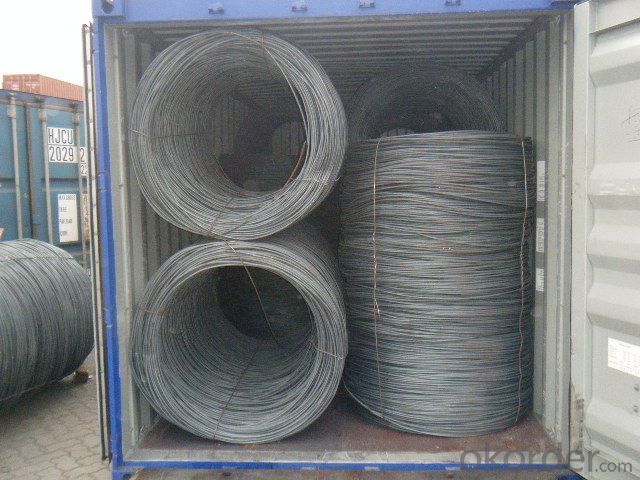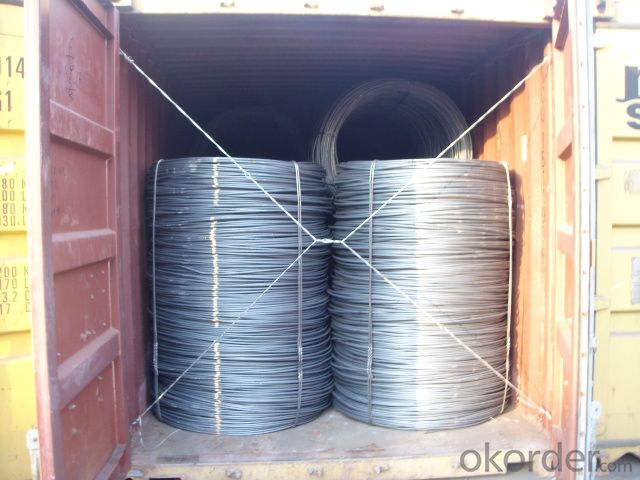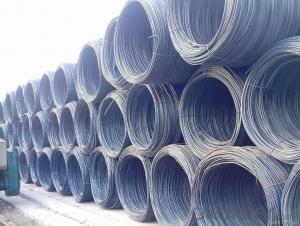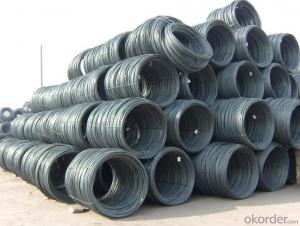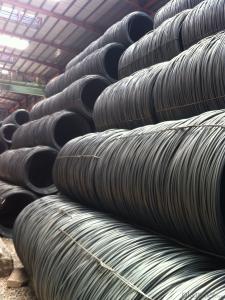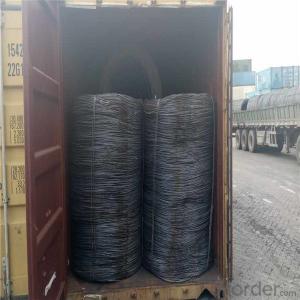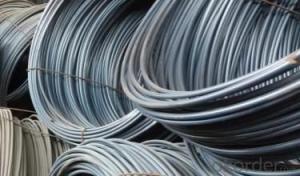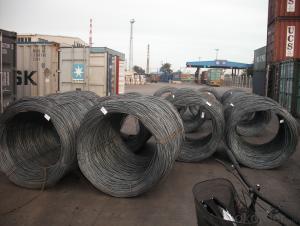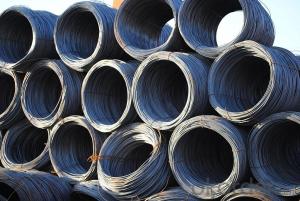Steel Wire Rod Low Carbon and Competitive Prices
- Loading Port:
- Tianjin
- Payment Terms:
- TT or LC
- Min Order Qty:
- 20 m.t.
- Supply Capability:
- 200000 m.t./month
OKorder Service Pledge
OKorder Financial Service
You Might Also Like
Product Description:
OKorder is offering Steel Wire Rod Low Carbon and Competitive Prices at great prices with worldwide shipping. Our supplier is a world-class manufacturer of steel, with our products utilized the world over. OKorder annually supplies products to European, North American and Asian markets. We provide quotations within 24 hours of receiving an inquiry and guarantee competitive prices.
Product Applications:
Steel Wire Rod Low Carbon and Competitive Prices are ideal for structural applications and are widely used in the construction of buildings and bridges, and the manufacturing, petrochemical, and transportation industries.
Product Advantages:
OKorder's Steel Wire Rod Low Carbon and Competitive Prices are durable, strong, and resist corrosion.
Main Product Features:
· Premium quality
· Prompt delivery & seaworthy packing (30 days after receiving deposit)
· Corrosion resistance
· Can be recycled and reused
· Mill test certification
· Professional Service
· Competitive pricing
Packaging & Delivery:
Packaging Detail: products are packed in bundle and then shipped by container or bulk vessel, deformed bar is usually naked strapping delivery, when storing, please pay attention to moisture proof. The performance of rust will produce adverse effect.
Each bundle weight: 2-3MT, or as required
Payment term: TT or L/C
Delivery Detail: within 45 days after received advanced payment or LC.
Label: to be specified by customer, generally, each bundle has 1-2 labels
Trade terms: FOB, CFR, CIF
FAQ:
Q1: Why buy Materials & Equipment from OKorder.com?
A1: All products offered byOKorder.com are carefully selected from China's most reliable manufacturing enterprises. Through its ISO certifications, OKorder.com adheres to the highest standards and a commitment to supply chain safety and customer satisfaction.
Q2: How do we guarantee the quality of our products?
A2: We have established an advanced quality management system which conducts strict quality tests at every step, from raw materials to the final product. At the same time, we provide extensive follow-up service assurances as required.
Q3: How soon can we receive the product after purchase?
A3: Within three days of placing an order, we will begin production. The specific shipping date is dependent upon international and government factors, but is typically 7 to 10 workdays.
Images:
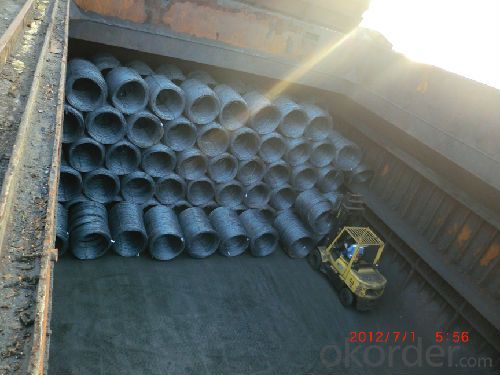
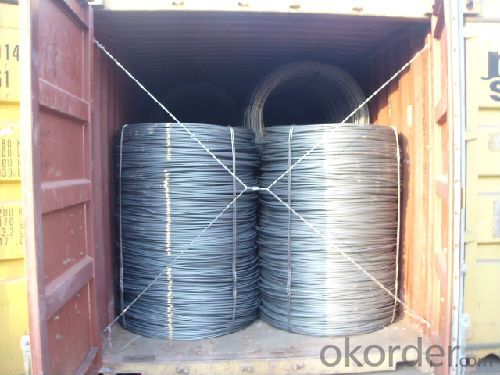
- Q: How does the brittleness of steel wire rod vary with different heat treatment processes?
- The brittleness of steel wire rod can vary significantly with different heat treatment processes. Heat treatment involves subjecting the steel wire rod to specific temperature and time conditions to alter its microstructure and consequently its mechanical properties. One commonly used heat treatment process is annealing, which involves heating the steel wire rod to a specific temperature and then slowly cooling it. This process helps to relieve internal stresses, refine the microstructure, and improve the ductility of the wire rod. As a result, annealed steel wire rod tends to have reduced brittleness and increased toughness. On the other hand, quenching is another heat treatment process that involves rapidly cooling the steel wire rod after heating it to a specific temperature. Quenching can result in the formation of a hardened microstructure, known as martensite, which can increase the strength of the wire rod. However, this process can also increase the brittleness of the material. Therefore, quenched steel wire rod tends to be more brittle compared to annealed wire rod. Another heat treatment process, known as tempering, is often used in conjunction with quenching to reduce the brittleness of the wire rod. Tempering involves reheating the quenched wire rod to a lower temperature, which allows for the redistribution of internal stresses and the transformation of some of the martensite into a more ductile microstructure. This process helps to improve the toughness and reduce the brittleness of the wire rod. In summary, the brittleness of steel wire rod can be influenced by different heat treatment processes. Annealing generally reduces brittleness and improves ductility, while quenching can increase brittleness but enhance strength. Tempering can then be used to reduce brittleness after quenching. The selection of the appropriate heat treatment process depends on the desired mechanical properties and the intended application of the steel wire rod.
- Q: How is steel wire rod used in the manufacturing of wire for 3D printing?
- In the process of manufacturing wire for 3D printing, steel wire rod serves as a vital component. It is utilized as the primary material for producing top-notch wire that finds application in various sectors within the 3D printing industry. To initiate the process, the suitability of steel wire rod for manufacturing is ensured through a series of rigorous quality control checks. These checks involve thorough examination of the rod's chemical composition, mechanical properties, and surface condition. Once the rod successfully passes these tests, it is considered appropriate for further processing. Subsequently, the steel wire rod is fed into a wire drawing machine, where it undergoes a procedure known as wire drawing. In this procedure, the rod is pulled through progressively smaller dies, resulting in the reduction of its diameter and an increase in its length. This process aids in enhancing the wire's surface finish and dimensional accuracy. Following the wire drawing stage, the steel wire undergoes additional processing to eliminate any impurities or contaminants present on its surface. This is accomplished through a process called pickling, wherein the wire is immersed in an acid solution to dissolve any oxides or scales that may have formed during wire drawing. This guarantees that the wire is clean and ready for subsequent manufacturing steps. The final step in the production of wire for 3D printing entails coating the steel wire with a layer of polymer or metal alloy. This coating serves multiple purposes, including improving the wire's adhesion to the printing bed, enhancing its durability, and providing a smooth surface finish to the 3D printed object. To summarize, steel wire rod plays a critical role in the manufacturing process of wire for 3D printing. Its exceptional tensile strength, remarkable mechanical properties, and ability to withstand high temperatures make it an ideal choice for producing wire that meets the demanding requirements of the 3D printing industry.
- Q: What are the major trends in the steel wire rod industry?
- There are several major trends currently shaping the steel wire rod industry. 1. Increasing demand: One of the most significant trends is the increasing demand for steel wire rods across various industries. The construction sector, automotive industry, and manufacturing sector are the primary drivers of this demand. This surge in demand can be attributed to the growing population, urbanization, and infrastructure development worldwide. 2. Technological advancements: The steel wire rod industry is undergoing significant technological advancements. These innovations are focused on improving the manufacturing process, enhancing the quality of wire rods, and reducing production costs. Automation, robotics, and data analytics are some of the key technological trends that are revolutionizing the industry. 3. Environmental sustainability: With increasing environmental concerns, the steel wire rod industry is also witnessing a shift towards more sustainable practices. Companies are adopting energy-efficient technologies, reducing emissions, and implementing recycling programs to minimize their environmental impact. This trend is driven by both regulatory requirements and the industry's commitment to sustainability. 4. Market consolidation: The steel wire rod industry is experiencing a trend of market consolidation, with larger companies acquiring smaller players and forming strategic partnerships. This consolidation is driven by the need to optimize production capacities, expand global reach, and achieve economies of scale. Such mergers and acquisitions are reshaping the competitive landscape of the industry. 5. Focus on product diversification: To stay competitive in the market, steel wire rod manufacturers are increasingly focusing on product diversification. This involves developing a wide range of wire rod products with varying specifications to cater to the diverse needs of different industries. Customization and flexibility in manufacturing are becoming crucial factors for success in the industry. Overall, the major trends in the steel wire rod industry revolve around increasing demand, technological advancements, environmental sustainability, market consolidation, and product diversification. These trends are driving the industry towards a more efficient, sustainable, and customer-centric future.
- Q: What are the factors that influence the mechanical properties of steel wire rod?
- The factors that influence the mechanical properties of steel wire rod include the composition of the steel, the heat treatment processes it undergoes, the manufacturing techniques used, and any additional treatments or coatings applied to the rod. Additionally, factors such as the diameter and surface finish of the wire rod can also impact its mechanical properties.
- Q: What are the potential risks and challenges in transporting steel wire rod?
- Careful management is required when transporting steel wire rods as there are various risks and challenges involved. To begin with, the weight and size of the rods can make transportation difficult. These rods are typically heavy and long, necessitating specialized equipment and vehicles for safe transport. If not handled and secured properly, there is a risk of the rods shifting or falling during transit, potentially causing damage to the cargo, the transport vehicle, or even posing a threat to other road users. Moreover, steel wire rods are susceptible to corrosion. Exposure to moisture, humidity, or harsh weather conditions can result in rusting, compromising the quality and strength of the rods. It is crucial to adequately protect the rods during transport to prevent moisture ingress and corrosion. Furthermore, the sharp ends of steel wire rods can present a safety hazard. These rods often have sharp edges or protruding ends, which can cause injuries to workers involved in handling or loading/unloading operations. It is essential to implement proper safety measures and provide protective gear to prevent accidents and injuries. In addition, transporting steel wire rods requires meticulous planning and coordination. These rods are often transported in large quantities, and their dimensions may require special permits or escorts. Routes and schedules must be carefully planned to ensure punctual delivery and avoid any legal or logistical complications. Lastly, theft and pilferage can be a major concern when transporting valuable steel wire rods. Due to their high value, these rods may attract the attention of thieves or unauthorized individuals. To mitigate the risk of theft, security measures such as tracking devices, secure storage facilities, and thorough background checks on personnel involved in the transportation process should be implemented. Overall, by implementing appropriate safety measures, security protocols, and careful planning, the risks and challenges associated with transporting steel wire rods can be effectively managed, ensuring the safe and timely delivery of the cargo.
- Q: How is the machinability of steel wire rod determined?
- The machinability of steel wire rod is determined by various factors such as its chemical composition, microstructure, hardness, and surface finish. These characteristics affect the ease with which the wire rod can be cut, drilled, or machined. Additionally, factors like the cutting tool material and geometry, cutting speed, and feed rate also play a role in determining the machinability of steel wire rod. By considering these factors, manufacturers can evaluate and optimize the machinability of steel wire rod for specific applications.
- Q: What are the common industry trends for steel wire rod?
- Some common industry trends for steel wire rod include increased demand from construction and automotive sectors, advancements in production technologies for higher quality and strength, growing emphasis on sustainability and environmental standards, and a shift towards digitalization and automation in manufacturing processes. Additionally, there is a focus on developing innovative alloys and coatings to enhance the performance and durability of steel wire rods in various applications.
- Q: What are the different types of steel wire rod surface finishing processes?
- There are several types of steel wire rod surface finishing processes, including pickling, galvanizing, phosphating, electroplating, and powder coating.
- Q: How are steel wire rods used in the manufacturing of wire baskets for storage and organization?
- Steel wire rods are a crucial component in the manufacturing of wire baskets for storage and organization. These rods serve as the raw material for creating the wire mesh that forms the structure of the basket. Firstly, the steel wire rods are subjected to a series of processes such as cleaning, straightening, and cutting to ensure that they are of the desired length and free from any impurities. Once prepared, the rods are then fed into a machine known as a wire-drawing machine, where they are drawn through a series of dies to reduce their diameter to the desired size. This process also helps in increasing the tensile strength of the wire. Next, the wire rods are fed into a wire mesh machine, where they are woven together to form a sturdy mesh pattern. The size of the mesh can be customized according to the specifications of the wire basket being manufactured. This mesh is then cut into sheets of the required dimensions. The sheets of wire mesh are then shaped and welded together to create the basket's structure. The steel wire rods not only provide strength and stability to the basket but also ensure that it can withstand the weight of the items being stored and prevent any deformation or bending. Furthermore, the wire rods can be coated or treated with different finishes, such as galvanization or powder coating, to enhance their durability and resistance to corrosion. This ensures that the wire baskets can be used in various environments, including damp or corrosive conditions, without degrading or losing their functionality. In conclusion, steel wire rods play a vital role in the manufacturing of wire baskets for storage and organization. They serve as the primary material for creating the wire mesh, which forms the structure of the basket. The strength, durability, and customization options provided by steel wire rods make them an essential component in creating functional and long-lasting wire baskets.
- Q: What are the main factors affecting the ductility of steel wire rod?
- The main factors affecting the ductility of steel wire rod are the composition of the steel, the heat treatment process, and the presence of impurities or defects in the material. Additionally, the mechanical properties of the wire rod, such as its grain size and the presence of dislocations, can also influence its ductility.
Send your message to us
Steel Wire Rod Low Carbon and Competitive Prices
- Loading Port:
- Tianjin
- Payment Terms:
- TT or LC
- Min Order Qty:
- 20 m.t.
- Supply Capability:
- 200000 m.t./month
OKorder Service Pledge
OKorder Financial Service
Similar products
Hot products
Hot Searches
Related keywords
